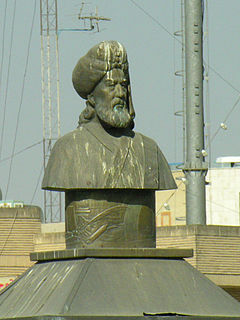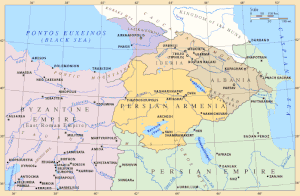
Kavad I was the Sasanian King of Kings of Iran from 488 to 531, with a two or three-year interruption. A son of Peroz I, he was crowned by the nobles to replace his deposed and unpopular uncle Balash.

Hormizd III, was the seventeenth king (shah) of the Sasanian Empire, ruling briefly from 457 to 459. He was the son and successor of Yazdegerd II. His reign was marked by the rebellion of his younger brother Peroz I, who with the aid of one of the Seven Great Houses of Iran, the House of Mihran, and the eastern neighbours of the Sasanians, the Hephthalites, had him captured and executed.

Peroz I was the Sasanian King of Kings of Iran from 459 to 484. A son of Yazdegerd II, he disputed the rule of his elder brother and incumbent king Hormizd III, eventually seizing the throne after a two-year struggle. His reign was marked by war and famine. Early in his reign, he successfully quelled a rebellion in Caucasian Albania in the west, and put an end to the Kidarites in the east, briefly expanding Sasanian rule into Tokharistan, where he issued gold coins with his likeness at Balkh. Simultaneously, Iran was suffering from a seven-year famine. He soon clashed with the former subjects of the Kidarites, the Hephthalites, who possibly had previously helped him to gain his throne. He was defeated and captured twice by the Hephthalites and lost his recently acquired possessions.

Yazdegerd II, was the Sasanian King of Kings of Iran from 438 to 457. He was the successor and son of Bahram V.

Balash was the Sasanian King of Kings of Iran from 484 to 488. He was the brother and successor of Peroz I, who had been defeated and killed by a Hephthalite army.

Shahrbaraz, was shah (king) of the Sasanian Empire from 27 April 630 to 9 June 630. He usurped the throne from Ardashir III, and was killed by Iranian nobles after forty days. Before usurping the Sasanian throne he was a spahbed (general) under Khosrow II (590–628). He is furthermore noted for his important role during the climactic Byzantine–Sasanian War of 602–628, and the events that followed afterwards.

Jamasp was Sasanian King of Kings of Iran from 496 to 498/9. He was a son of Peroz I and younger brother of Kavad I. Jamasp was installed on the Sasanian throne upon the deposition of the latter by the nobility and clergy.

Bozorgmehr-e Bokhtagan, also known as Burzmihr, Dadmihr and Dadburzmihr, was an Iranian sage and dignitary from the Karen family, who served as minister of the Sasanian king (shah) Kavad I, and the latter's son and successor Khosrow I. He also served as the military commander (spahbed) of Khwarasan under Khosrow I and his successor Hormizd IV. According to Persian and Arabic sources, Bozorgmehr was a man of "exceptional wisdom and sage counsels" and later became a characterisation of the expression. His name appears in several important works in Persian literature, most notably in the Shahnameh. The historian Arthur Christensen has suggested that Bozorgmehr was the same person as Borzuya, but historiographical studies of post-Sasanian Persian literature, as well as linguistic analysis show otherwise. However, the word "Borzuya" can sometimes be considered a shortened form of Bozorgmehr.

Sasanian Armenia, also known as Persian Armenia and Persarmenia, may either refer to the periods in which Armenia was under the suzerainty of the Sasanian Empire or specifically to the parts of Armenia under its control such as after the partition of 387 when parts of western Armenia were incorporated into the Eastern Roman Empire while the rest of Armenia came under Sasanian suzerainty but maintained its existing kingdom until 428.
Farrukhzad, was an Iranian aristocrat from the House of Ispahbudhan and the founder of the Bavand dynasty, ruling from 651 to 665. Originally a powerful servant of the Sasanian king Khosrow II, he, along with several other powerful aristocrats made a conspiracy against the latter and ended his tyrannical rule. They thereafter put Khosrow's son Kavadh II on the throne, whose rule lasted only a few months, before he was killed by a plague, being succeeded by his son Ardashir III, who was only after one year murdered by the rebellious former Sasanian army chief (spahbed) Shahrbaraz, who usurped the throne.

Vistahm or Bistam, was a Parthian dynast of the Ispahbudhan house, and maternal uncle of the Sasanian king of kings of Iran, Khosrow II. Vistahm helped Khosrow regain his throne after the rebellion of another Parthian noble Bahram Chobin, of House of Mihran, but later led a revolt himself, and ruled independently over a region which encompassed the entire Iranian East until he was defeated by Khosrow and his allies.

Mihr-Narseh, was a powerful Iranian dignitary from the House of Suren, who served as minister of the Sasanian shahanshahs Yazdegerd I, Bahram V, Yazdegerd II and Peroz I. According to the Iranologist Richard N. Frye, Mihr-Narseh was the "prototype of the later Islamic grand vizier."
Piruz Khosrow, also known as Piruzan or Firuzan, was a powerful Persian aristocrat who was the leader of the Parsig (Persian) faction that controlled much of the affairs of the Sasanian Empire during the Sasanian civil war of 628-632. He was killed at the Battle of Nahāvand in 642.

The Sasanian civil war of 628–632, also known as the Sasanian Interregnum was a conflict that broke out after the execution of the Sasanian king Khosrau II between the nobles of different factions, notably the Parthian (Pahlav) faction, the Persian (Parsig) faction, the Nimruzi faction, and the faction of general Shahrbaraz. Rapid turnover of rulers and increasing provincial landholder power further diminished the empire. Over a period of 4 years and 14 successive kings, the Sasanian Empire weakened considerably, and the power of the central authority passed into the hands of its generals, contributing to its fall.

Sukhra was an Iranian nobleman from the House of Karen, who was the de facto ruler of the Sasanian Empire from 484 to 493. He was active during the reign of shah Peroz I, Balash and Kavad I. He is often confused with his father Zarmihr Hazarwuxt and son Zarmihr Karen.
Zarmihr Hazarwuxt was an Iranian military leader from the House of Karen, who served as the marzban of Sasanian Armenia briefly in 483.
Shapur Mihran, known in Armenian sources as Shapuh Mihran, was a Sasanian nobleman from the House of Mihran. He served as the marzban of Persian Armenia briefly in 482.
Wuzurgan, also known by its Modern Persian form of Bozorgan (بزرگان), was the name of the high nobility and the third class-rank of the four of the Sasanian aristocracy. After the fall of the Sasanian Empire, they reappear under the Dabuyid dynasty.

Harev, was a Sasanian province in Late Antiquity, that lay within the kust of Khorasan. The province bordered Kushanshahr in the west, Abarshahr in the east, Marv in the north, and Sakastan in the south.
This is an alphabetical index of people, places, things, and concepts related to or originating from the Sasanian Empire (224–651). Feel free to add more, and create missing pages.














